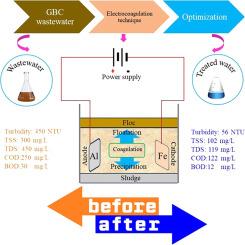当前位置:
X-MOL 学术
›
Water Res.
›
论文详情
Our official English website, www.x-mol.net, welcomes your
feedback! (Note: you will need to create a separate account there.)
Electrocoagulation treatment of wastewater collected from Haldia industrial region: Performance evaluation and comparison of process optimization
Water Research ( IF 11.4 ) Pub Date : 2024-10-29 , DOI: 10.1016/j.watres.2024.122716 Uma Sankar Behera, Sourav Poddar, Hun-Soo Byun
Water Research ( IF 11.4 ) Pub Date : 2024-10-29 , DOI: 10.1016/j.watres.2024.122716 Uma Sankar Behera, Sourav Poddar, Hun-Soo Byun

|
This study investigates the treatment of oil-contaminated wastewater with high levels of inorganic substances, suspended solids and turbidity, collected from the Haldia industrial region of India in February 2023. The wastewater, originating from industries such as chemical, petrochemical, textile, and battery manufacturing, presents a complex pollutant load that challenges traditional treatment methods. Electrocoagulation was employed as the treatment technique, with process optimization conducted using Box-Behnken design (BBD) and central composite design (CCD) for key parameters: pH, initial oil concentration, current density, and electrolysis time. The study comprehensively examined the effects of these parameters on turbidity removal. The optimal conditions were determined to be a pH of 7.5, an initial oil concentration of 275 mg/L, a current density of 17.5 mA/cm², and an electrolysis time of 20 min. Under these conditions, CCD outperformed BBD, achieving a desirability score of 93 % compared to 80 % for BBD. The process successfully reduced turbidity from 450 NTU to 56 NTU and total suspended solids (TSS) from 300 mg/L to 102 mg/L. The operation cost of the process was found to range from ₹0.904/m³ to ₹2.71/m³ as the electrolysis time increased from 0.17 to 0.5 h. The study presents a viable solution for industrial wastewater treatment in this region, aligning with the United Nations Sustainable Development Goal (UN SDG) 2030. Additionally, combining electrocoagulation with membrane filtration may enhance comprehensive pollutant removal.
中文翻译:

对 Haldia 工业区收集的废水进行电絮凝处理:性能评估和工艺优化比较
本研究调查了 2023 年 2 月从印度 Haldia 工业区收集的含高无机物、悬浮固体和浊度的受石油污染的废水的处理情况。这些废水来自化工、石化、纺织和电池制造等行业,具有复杂的污染物负荷,对传统的处理方法提出了挑战。采用电絮凝作为处理技术,使用 Box-Behnken 设计 (BBD) 和中心复合设计 (CCD) 对关键参数进行工艺优化:pH 值、初始油浓度、电流密度和电解时间。该研究全面检查了这些参数对浊度去除的影响。确定最佳条件为 pH 值为 7.5,初始油浓度为 275 mg/L,电流密度为 17.5 mA/cm²,电解时间为 20 min。在这些条件下,CCD 的表现优于 BBD,达到 93% 的意愿得分,而 BBD 的意愿得分为 80%。该工艺成功地将浊度从 450 NTU 降低到 56 NTU,将总悬浮固体 (TSS) 从 300 mg/L 降低到 102 mg/L。随着电解时间从 0.904 小时增加到 2.71 小时,发现该工艺的运营成本从 0.17 卢比/立方米到 0.5 卢比/立方米不等。该研究为该地区的工业废水处理提供了一种可行的解决方案,符合联合国 2030 年可持续发展目标 (UN SDG)。此外,将电凝法与膜过滤相结合可以增强污染物的全面去除。
更新日期:2024-10-29
中文翻译:

对 Haldia 工业区收集的废水进行电絮凝处理:性能评估和工艺优化比较
本研究调查了 2023 年 2 月从印度 Haldia 工业区收集的含高无机物、悬浮固体和浊度的受石油污染的废水的处理情况。这些废水来自化工、石化、纺织和电池制造等行业,具有复杂的污染物负荷,对传统的处理方法提出了挑战。采用电絮凝作为处理技术,使用 Box-Behnken 设计 (BBD) 和中心复合设计 (CCD) 对关键参数进行工艺优化:pH 值、初始油浓度、电流密度和电解时间。该研究全面检查了这些参数对浊度去除的影响。确定最佳条件为 pH 值为 7.5,初始油浓度为 275 mg/L,电流密度为 17.5 mA/cm²,电解时间为 20 min。在这些条件下,CCD 的表现优于 BBD,达到 93% 的意愿得分,而 BBD 的意愿得分为 80%。该工艺成功地将浊度从 450 NTU 降低到 56 NTU,将总悬浮固体 (TSS) 从 300 mg/L 降低到 102 mg/L。随着电解时间从 0.904 小时增加到 2.71 小时,发现该工艺的运营成本从 0.17 卢比/立方米到 0.5 卢比/立方米不等。该研究为该地区的工业废水处理提供了一种可行的解决方案,符合联合国 2030 年可持续发展目标 (UN SDG)。此外,将电凝法与膜过滤相结合可以增强污染物的全面去除。


















































 京公网安备 11010802027423号
京公网安备 11010802027423号